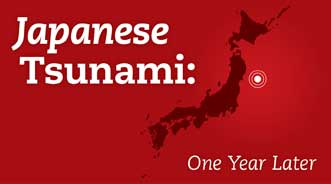Tsunami Remembered: An Unforgettable Mark

Just over a year ago, chaos reined in Japan as suppliers took on flood waters and OEMs scrambled to cover their supply chains. A nuclear facility stood in possible meltdown mode, and more than 15,000 individuals were declared dead or missing. With the massive earthquake and tsunami crippling a corner of the country on March 11, 2011, all the auto industry could do was sit and watch.
To put what happened into perspective, Auto Remarketing reached out to OEMs, dealers and industry analysts who all shared frank assessments of what the 9.0 magnitude earthquake off of the northeast coast of Japan on March 11 and the resulting tsunami did.
Before delving into vehicles both on the production line and in the showroom, TrueCar’s Jesse Toprak first focused on the human toll the disaster took.
“It was tough to think about the business angle because of the human aspect of the story,” the site’s vice president of industry trends and insights acknowledged to Auto Remarketing.
Kelley Blue Book’s Alec Gutierrez remembered exactly where he was when disaster declarations began filling all media outlets.
“I was at the NAAA/CAR Conference in Las Vegas when the earthquake hit, and I just remember staying up all night watching footage from my hotel room.,” recalled KBB’s senior market analyst for automotive insights.
Even a year later, Andrew Bernhard, director of global automotive operations for J.D. Power and Associates, paused to remember the victims before touching on any automotive-related consequences.
“We can never truly comprehend the immense tragedy that the country experienced and I would be very hesitant to comment — only that it amazing to see the resilience of the country and the people in Japan,” Bernhard told Auto Remarketing.
How Critical Japan Is to Global Auto Industry
If executives and consumers didn’t already know how much the Asian country meant to vehicles production and sales, the disaster placed a laser focus on the fact.
“Japan, including automakers, had long seemed invincible,” surmised Edmunds.com senior analyst Michelle Krebs. “Surely they were meticulously prepared for any disaster the way buildings in Japan supposedly were built to endure the frequent earthquakes that occur. Surely there was an emergency plan in place that would be perfectly executed. Instead, buildings fell, nuclear plants failed, auto plants and supplier facilities shut down — and the country was in confusing disarray.
“The March 11 earthquake and tsunami revealed the vulnerabilities of the nation and its industries, including the auto industry,” Krebs continued.
Bernhard took a similar path when discussing the manufacturing impact.
“It truly brought to light the industry’s complete reliance on the supply chain,” he declared. “Due to the recent hurdles the industry has faced and the implementation of multiple cost-cutting metrics — there was exposure to both production bandwidth and component inventory, and the lack of banked components and multiple sourced suppliers — led to the reduction in production (and for that matter, sales as well) for many OEMs.
“At the same time you were able experience how effective leadership, dedicated personal and robust processes were able to adapt to the continuous change and maintain and run a business day to day,” Bernhard went on to say.
From a production angle, Toprak delved into what automakers — both Japanese and others — learned from the disaster.
“The just-in-time production that Japanese ran their success stories on for decades showed its weak side, which was that if the production chain is disrupted for a long time, just-in-time inventory management basically falls apart,” Toprak explained.
“Ironically, the old-fashioned supply chain management of the domestic automakers where there a good backlog of parts that are waiting in warehouses — the opposite of just-in-time production — gave them an advantage this time around,” he continued.
“Perhaps a hybrid approach could be the end result,” Toprak surmised.
Permanent Market Share Effects?
Gutierrez told Auto Remarketing that more than anything else the tragedy’s biggest impact on the auto industry was Toyota and Honda’s loss of market share stemming from the disruption of their supply chain and subsequent production halt.
“Although Toyota and Honda, similar to all manufacturers that have production facilities located around the globe, they were severely limited in their ability to produce vehicles due to the lack of critical components needed for production,” Gutierrez explained.
“In the few months following the earthquake both Toyota and Honda lost 3 to 4 points of market share as inventory declined by 70 and 50 percent, respectively,” he continued. “Both inventory and market share have yet to return to pre-earthquake levels for Toyota and Honda.
“Nissan on the other hand, after taking a slight dip in market share and inventory, has already fully recovered and has been increasing share in recent months,” Gutierrez added.
How should sales be compared when looking at year-over-year numbers as 2012 unfolds?
“Sales lost through this period will never be recovered,” Gutierrez contended. “Although die-hard loyalists may have waited for Toyota and Honda to recover before purchasing a new vehicle, many consumers opted to jump ship to purchase a new Ford, Chevrolet or Hyundai.
“While Toyota and Honda remained unable to satisfy demand, the competition around them was better than ever, giving consumers plenty of reason to look elsewhere,” he insisted. “In just the last few years the critically acclaimed Hyundai Sonata has arrived to challenge Accord and Camry while the Civic and Corolla are now facing stiff competition from the all-new Cruze and redesigned Focus, Elantra, and Jetta.
“If the earthquake had hit five years ago,” Gutierrez pondered, “Honda and Toyota would have been in a better position to weather the storm. However, today, consumers have plenty of competitive alternatives to the best Toyota and Honda have to offer.”
Gutierrez also shared data charts KBB assembled on the performance of Toyota, Honda and Nissan after the disaster.
Editor’s Note: Later this week in Auto Remarketing’s series, Japanese Tsunami: One Year Later, reports will give perspective from dealers and OEMs, as well as wholesale analysis from ADESA and Manheim.

 View The Latest Edition
View The Latest Edition

